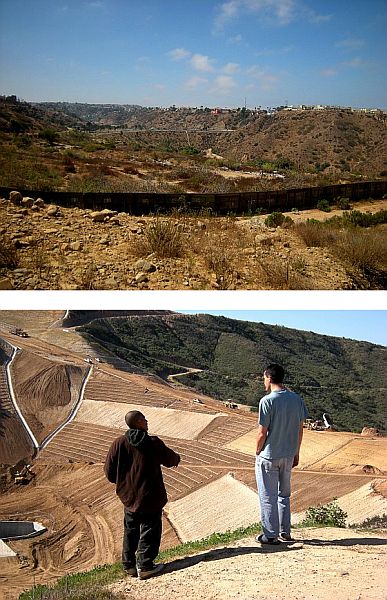
5 March 2013
Travel is very educational. Not only are there different birds in San Diego but the threats those birds face are different from what I’m used to in Pittsburgh. One issue particularly grabbed my attention because we never have to deal with it at home.
Where I come from it’s hard to imagine the wall that defines the southern edge of San Diego County and most of the U.S. border from here through Texas. Like the Berlin Wall it’s patrolled by armed guards, edged by cleared land for easy enforcement, and in places triple-fenced.
The border has been patrolled for a long time but the Real ID Act of 2005 mandated the border wall and exempted its construction from every environmental law including the Endangered Species Act, the Migratory Bird Treaty Act, the Clean Water Act, the Clean Air Act, and the National Environmental Policy Act. Exemptions like this bring to mind mountaintop removal in West Virginia.
During design of the Triple Fence, San Diego Audubon and other groups tried to prevent the worst environmental damage but it was impossible to stop the juggernaut. Now that the wall is up, they’re working with California State Parks and the Tijuana National Estuarine Research Reserve to monitor the wall’s effect on sedimentation, erosion, and invasive plants.
There are lots of problems to monitor. Here are just two examples.
The fence through Yogurt Canyon, shown above, disrupts the natural drainage into the Tijuana Estuary to the north. This affects everything that depends on the water, including birds.
At Border Field State Park, shown below, the wall’s construction leveled Litchy Mesa and filled Smugglers Gulch. There used to be a single fence. Now there’s a massive valley-fill and all the issues that come with it.
Ironically, the wall has an unintended consequence. In the old days workers used to migrate back and forth like the birds — north for planting and harvesting, south to their homes in the winter.
In his 2001 book, Crossing Over, Rubén Martínez described how the patrols even then were ending the return migration. It’s now so dangerous at the wall that those who make it to the U.S. rarely leave — because they can’t.
I’m sure that’s not the result the wall’s proponents had in mind.
Read more about the border fence and how it affects the land and people of Tijuana and San Diego in Jill Marie Holslin’s blog At The Edges.
(photos used by permission of Jill Marie Holslin from her blog, At the Edges. Click on each image for more information.)

Fences have never addressed or stopped the real problem, illegal employers. But,like alien plants, have merely introduced new problems. And the beat goes on.
Kate, have you been dahn the Sahth Side to visit them Bald Eagles yet?
http://pittsburgh.cbslocal.com/2013/02/27/2-bald-eagles-build-nest-in-citys-hays-neighborhood/
Yes I have. It’s hard to find a vantage point other than the bike trail.
The environmental impacts of the border wall stretch from the Pacific to the Gulf of Mexico, from Otay Mountain Wilderness Area to the Lower Rio Grande Valley National ?Wildlife Refuge. And they are ongoing. This time last year the International Boundary Water Commission reversed itself and approved new border walls in the Rio Grande floodplain in South Texas, ignoring treaty obligations and the impacts on migratory bird and endangered ocelot habitat. http://www.notexasborderwall.blogspot.com/2012/09/will-walls-worsen-rio-grande-flooding.html